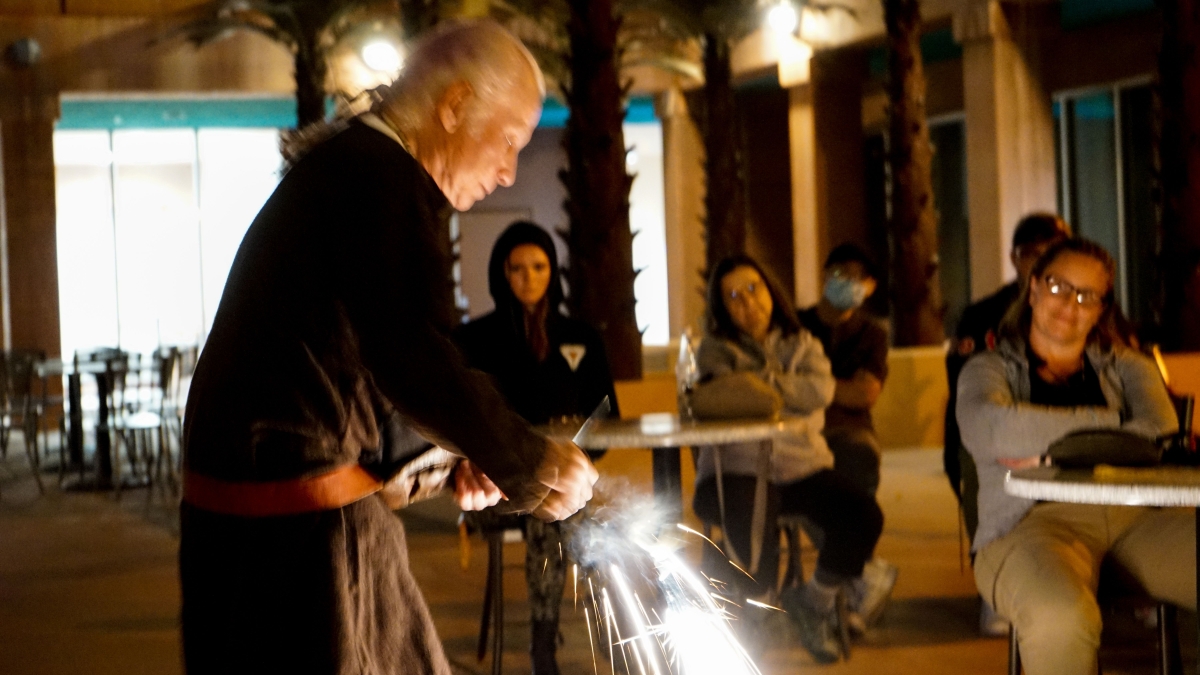Iron Age gear, survival techniques intrigue parks and recreation students

John "Bluebird" Crossman demonstrates several tools with origins in the Iron Age for PRM 340 students.
Students in McKenna Brodrick‘s outdoor survival class are used to talking about roughing it in this century.
As they gathered on benches outside Hayden Library on Arizona State University's Tempe campus one recent chilly Monday evening to greet their guest speaker, they got an eyeful of what it might have looked like to survive, old-school style, in another era.
Very old school.
Brodrick, a faculty associate in the School of Community Resources and Development, had given them a hint beforehand about what to expect from their guest. But John “Bluebird” Crossman still was quite a fascinating sight as he approached, dressed in a handmade outfit that he said would have been encountered during the Iron Age in Europe.
Crossman, founder of the Phoenix-based Bluebird’s Survival and Ancient Skills School, walked up in a wool tunic and pants, a belt with a bird emblem that held a steel knife tucked in its sheath, a pair of sandals held together with yarn and knitted stockings. Tucked in his long purple and white hair was a bone awl.
Bone is the best material to make tools because it’s strong and easy to re-sharpen, according to Crossman. “It’s like a Swiss Army knife,” he said later on.
He said his nickname, “Bluebird,” was given to him in 1976. After making his first-ever teepee with dark blue, heavy cloth – he couldn’t justify the expense of real canvas – someone called out, “Hey, Bluebird, that’s a mighty fine looking teepee!"
Crossman dragged a cart behind him that was filled with handmade survival gear, including a fire-starting kit and a hat made of canvas and beeswax that doubles as a bucket.
After being introduced to the class, he took a drink of water from a plastic bottle, joking he needed some whiskey, then launched into his lecture.
Crossman focused on three main points: Primitive shelter, early humans and the beginnings of fire.
“My joy is sharing what makes me happy,” he said when his time was up.
Students were invited to stay after to get a closer look at Crossman’s survival gear.
“(My favorite part) was the fire starter he had made using a piece of charcoal cloth,” said Marshall Morgan, a senior double major in sustainability and history. “That was something that I would never have even considered.”
A close-up view of several outdoor survival tools with origins in the Iron Age demonstrated for a PRM 340 class by John "Bluebird" Crossman.
Morgan enrolled in the class, PRM 340, to fulfill a requirement for his minor in parks and protected area management.
“This course is unlike any other course I’ve taken,” he said. “The course itself is very fun, interactive and just overall (an) amazing experience.”
Students learn more than just the physical aspects of survival in ASU’s outdoor survival class.
“I want (the students) first and foremost to be able to stay calm and think clearly,” Brodrick said. “I want them to be able to apply what they learn to everyday life and to walk away from this class feeling confident and strong in their decisions.”
Brodrick, the class instructor, first fell in love with the outdoors during her first family camping trip. The entire family slept under a tarp.
“It was pouring rain and that tarp … only covered like half of me,” she said. “I remember looking up at the rain coming down and thinking, ‘It feels like I should be miserable, and I’m not at all.’ It felt like it was an adventure.”
When she was 14, she started designing backpacking trips, and in 2000, she became certified as a wilderness first responder.
This is Brodrick’s fourth semester teaching outdoor survival at ASU. Students in the class meet in many locations around campus throughout each semester, including the atrium in the Farmer Education Building, the Secret Garden behind West Hall and outside the Student Services Building.
Later in the semester, students will embark on an outdoor, overnight practicum in which they will demonstrate skills they’ve learned in the course. This includes building a shelter, making a fire with no lighters or matches, purifying water and more.
Story and photos by Amber Victoria Singer, student journalist, ASU School of Community Resources and Development.
More Environment and sustainability

ASU to host new Global Coordination Hub
In a new partnership between the global research network Future Earth and Arizona State University, the Julie Ann…

A world full of plastic ... not fantastic
Editor’s note: This is the seventh story in a series exploring how ASU is changing the way the world solves problems.…

Team wins $10M XPRIZE Rainforest competition for novel solution
Several Arizona State University experts are on a team that created a new way to put a price on the rainforest in order to save…
